Abstract
In view of the unsatisfactory treatment of cognitive disorders, in particular Alzheimer’s disease (AD), the aim of this review was to perform a computer-aided analysis of the state of the art that will help in the search for innovative polypharmacology-based therapeutic approaches to fight against AD. Apart from 20-year unrenewed cholinesterase- or NMDA-based AD therapy, the hope of effectively treating Alzheimer’s disease has been placed on serotonin 5-HT6 receptor (5-HT6R), due to its proven, both for agonists and antagonists, beneficial procognitive effects in animal models; however, research into this treatment has so far not been successfully translated to human patients. Recent lines of evidence strongly emphasize the role of kinases, in particular microtubule affinity-regulating kinase 4 (MARK4), Rho-associated coiled-coil-containing protein kinase I/II (ROCKI/II) and cyclin-dependent kinase 5 (CDK5) in the etiology of AD, pointing to the therapeutic potential of their inhibitors not only against the symptoms, but also the causes of this disease. Thus, finding a drug that acts simultaneously on both 5-HT6R and one of those kinases will provide a potential breakthrough in AD treatment. The pharmacophore- and docking-based comprehensive literature analysis performed herein serves to answer the question of whether the design of these kind of dual agents is possible, and the conclusions turned out to be highly promising.
1. Introduction
Reduced cognitive capacity is a growing problem, becoming as common as diseases such as obesity, cancer and heart disease. Cognitive decline usually, but not always, occurs in elderly people and may have light symptoms such as forgetting information and difficulty in memorizing situations; these light symptoms are categorized as mild cognitive impairment (MCI) [1,2]. Although such symptoms are not extremely problematic in everyday life, they may be the first sign of developing dementia, a serious cognitive dysfunction leading to obstacles in performing simple tasks and very often to loss of functional independence [3]. Worryingly, about 50 million people in the world suffer from dementia [4]. Interestingly, 70% of reported cases are a consequence of Alzheimer’s Disease (AD), i.e., the complex central nervous system disorder, occurring usually after 60 years of age [5]. Unfortunately, despite the huge number of studies, the available small molecule drugs used for treatment have significant limitations: improvement in cognition is observed for only a short time and the drugs treat only the symptoms of the disease, rather than its influence or causes [6]. Their pharmacodynamic action concentrates on two protein targets: (i) inhibition of acetylcholinesterase (AChE) in the case of donepezil, galantamine and rivastigmine, and (ii) antagonism towards N-methyl-D-aspartate receptor (NMDA) for memantine [7]. In 2021, after almost a twenty-year break, the FDA approved the first disease-modifying option for AD treatment, the monoclonal antibody aducanumab, which gave hope for a breakthrough in AD therapy [8]. However, the FDA’s accelerated acceptance of this pathway caused a significant amount of controversy in the scientific community, as the results from different clinical studies were not consistent, thus not clearly confirming the therapeutic efficacy [9]. Moreover, the approval was mainly based on the ability of aducanumab to remove β-amyloid (Aβ) plague, whereas it has not yet been proved that Aβ clearance is correlated with cognition impairment. Finally, the cost of the treatment and the safety profile were also problematic issues [10]. In this light, searching for novel small chemical entities acting via non-standard protein targets is highly urgent to deal with this still unmet clinical need.
On the other hand, in the last few decades, serotonin 5-HT6 receptor (5-HT6R) and its ligands have been strongly investigated in terms of potency to fight cognition dysfunctions [11,12]. In many preclinical studies, it has been confirmed that both agonism and antagonism of 5-HT6R influences improvement in cognition capacity [13]. However, all the selective 5-HT6R agents that reached clinical studies were sub-efficacious in AD patients [14]. This disappointing lack of translatability of preclinical findings to human applications has encouraged the development of novel therapeutic strategies. One of them concerns polypharmacology, i.e., an approach that, opposite to the paradigm “one drug, one target”, aims at designing molecules with action via two or more therapeutic proteins. It is supposed that the clinical failure of 5-HT6R agents is a consequence of the fact that those anti-AD drug candidates have been designed as single-target molecules, whereas such a complex disease as AD involves many different signaling pathways that form the pathological network [15]. Hence, selecting just one target may indeed lead to insufficiency [16]. Moreover, multidirectional molecules may have a more predictable pharmacokinetic profile than combined therapy with two or more single-target drugs [17,18]. These arguments have encouraged medicinal chemists to design and synthesize compounds with such a multifunctional profile. Based on the great potency in preclinical studies of the 5-HT6R ligands, it seems to be reasonable to combine such activity with targeting protein(s) that is/are also involved in the pathology of cognition processes. Until now, most of the reported multifunctional 5-HT6R ligands also have potency to inhibit the activity of cholinesterases (AChE—acetylcholinesterase and BuChE—butylcholinesterase [19]), dopamine D3 receptor [20] and other serotoninergic receptors, e.g., 5-HT4R [21].
Among the hallmarks of AD, the formation of the three following components: (i) the neurofibrillary tangles; (ii) the amyloid plaques and (iii) the insoluble Aβ, are the most important ones. Aβ is produced via the amyloidogenic degradation of the amyloid precursor protein (APP) with the contribution of both β and γ-secretases. Although the exact causes of AD are still unknown, the number of factors recognized as contributing to AD etiology increases every year and are assigned to various signaling pathways with specific kinases as the main players. Hence, this class of kinases should also be taken into consideration as therapeutic targets in the search for multifunctional anti-AD agents.
Given the urgent need for the development of innovative and effective procognitive therapies, this review is focused on computer-aided analysis of the possibility of designing novel multidirectional molecules with combined action via serotonin 5-HT6R and carefully selected kinases. Thus, (i) microtubule affinity-regulating kinase 4 (MARK4), (ii) Rho-associated coiled-coil-containing protein kinase I/II (ROCKI/II) and (iii) cyclin-dependent kinase 5 (CDK5) were considered for discussion, since these proteins are innovative as AD therapeutic targets, according to recent state of the art research, and, simultaneously, have not yet been considered in terms of combination with 5-HT6R activity.
2. 5-HT6R Ligands—Pharmacophore Features
2.1. Chemical Variety of 5-HT6R Ligands
Since the discovery of 5-HT6R in the mid-1990s, over a thousand of its ligands with the nanomolar affinity range and a diverse functional activity profile have been identified. Although this intrinsic activity does not define clear preferences for potential therapeutic actions, as procognitive, antidepressant-like and anxiolytic effects in animal models were confirmed either for agonists or antagonists, the 5-HT6R antagonists are of greater interest to researchers; 17 have reached clinical trials, including 6 towards AD [22]. On the other hand, the chemical space of 5-HT6R ligands is rather narrow, predominantly mapped by sulfonamide, indole and indole-like moieties, also containing a basic center most often represented by N-unsubstituted- or N-methylpiperazine (Figure 1).
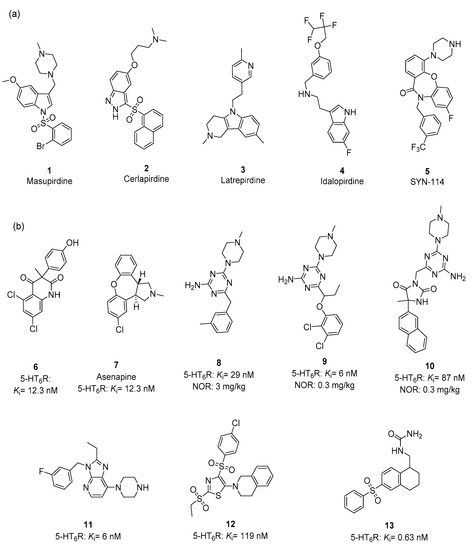
Figure 1.
The structural variety of 5-HT6R antagonists: (a) compounds 1 [23,24], 2 [25], 3 [26,27,28,29], 4 [30,31,32] and 5 [33] investigated in clinical trials; (b) compounds in the early stages of R&D: the non-indole and non-sulfone derivatives 6 [34], 7 [35], 8 [36,37], 9 [38,39], 10 [40,41]and 11 [42] and non-basic antagonists 12 [43] and 13 [43,44]. The affinity for 5-HT6R expressed with Ki (nM). Procognitive effects in the Novel Object Recognition (NOR) test for 8–10. at the dose shown [36,37,38,39,40,41].
According to the statistics provided in 2014, 80% of 5-HT6R ligands contain sulfone moieties, while 40% contain indole ones [45]. Thus, one of the two most advanced in clinical trials, masupirdine, consists of three aforementioned moieties (1) [23,24], while cerlapirdine (2) [25]is the sulfonamide derivative, two non-sulfone but indole-derived 5-HT6R antagonists, latrepirdine (3) [26,27,28,29] and idalopirdine (4) [30,31,32] failed in Phase III of clinical trials, and only one non-sulfone and non-indole derivative SYN-114 (5) [33] was active in Phase I (Figure 1a). Recent research results have contributed to increasing the chemical diversity of 5-HT6R ligands. Apart from the structures of quinoline-2,4-diones (6) [34] and asenapine (7) [35] described in 2008–2009, the last five years have also provided non-indole and non-sulfonic derivatives of triazine (8, 9) [36,37,38,39], hydantoin (10) [40,41], imidazopyridine (11) [42], as well as non-basic 5-HT6R ligands (12, 13) [43,44], which also showed procognitive activity in animal models (8–10), promising for potential AD therapies (Figure 1b).
Both ligand-based (LBDD) and structure-based drug design (SBDD) approaches are useful in the rational design of 5-HT6R ligands. However, a limitation to SBDD was the lack of a crystallographic structure for this receptor in PDB until now, thus condemning designs based on homology models. Last-minute lines of evidence [46] point to obtaining the first 5-HT6R crystal, which gives hope for increasing SBDD efficiency as soon as the crystallographic structure becomes available. Nevertheless, the ligand-based design has dominated the exploration of the chemical space for new 5-HT6R ligands so far, in which the pharmacophore model for antagonists developed by the team of Lopez-Rodriguez in 2005 seems to be the number one for the computer-aided LBDD, until now.
2.2. Molecular Modeling Approaches to Evaluate the Potential 5-HT6R Compound Activity
We decided to combine both LBDD and SBDD to assess the potential of considered kinases inhibitors that also present 5-HT6R activity (detailed results are presented in the respective subchapters). At first, we used the pharmacophore-based method in order to examine the possibility of dual modulation of the 5-HT6R and each kinase selected from the considered ones (MARK4, ROCK I, ROCK II, CDK5) in a wider group of chemical compounds.
Taking into account the significant increase in the number of new highly active 5-HT6R antagonists for more than 15 years since the pharmacophore of Lopez-Rodriguez occurred, an update based on the extensive library of current antagonists (ligands) available in the CHEMBL database for the 5-HT6R pharmacophore model was made in the first step.
The developed pharmacophore was further used to analyze common structural features for the active kinase inhibitors and 5-HT6R.
For all 5-HT6R ligands with affinity to the receptor below 500 nM (expressed in Ki, data fetched from the ChEMBL database) [47], the clustering procedure was carried out (with compounds represented by MOLPRINT2D fingerprint [48] and Tanimoto similarity metric used to measure distance between the clusters formed). The number of clusters was forced to be 50, and centroids together with compounds with the shortest distance to the centroid formed the set of compounds, which was used to construct the pharmacophore model (the total number of compounds was equal to 136). The clustering procedure was applied to ensure that the chemical space of ligands used for the pharmacophore model construction was representative to the whole set of 5-HT6R ligands to the highest possible extent.
The pharmacophore model was constructed using Phase [49] from the Schrödinger Suite 2022 (Figure 2).
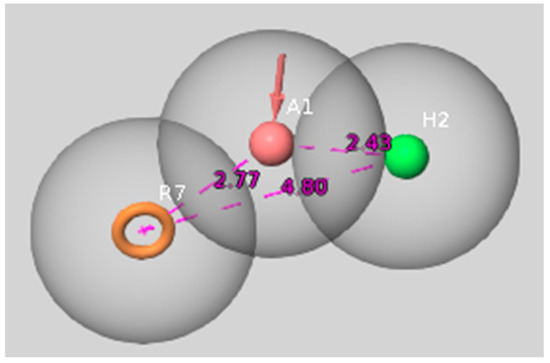
Figure 2.
Pharmacophore model of the 5-HT6R ligands: aromatic moiety (R7), hydrogen bond acceptor (A1), hydrophobic moiety (H2).
Due to the relatively high fraction of 5-HT6R ligands with low basicity, the positive ionizable group, which was present in pharmacophore models developed in previous studies [22], is now not included in the model. The model is composed of three features: aromatic moiety (R7), hydrogen bond acceptor(A1) and hydrophobic moiety (H2). The features are arranged in the triangle-like shape with the distance between the aromatic ring and hydrogen bond acceptor equal to 2.77 Å, between hydrogen bond acceptor and hydrophobic feature: 2.43 Å, and 4.80 Å between the aromatic feature and hydrophobic moiety.
Mapping of the example 5-HT6R ligand (CHEMBL267615, Ki = 13 nM) on this model is presented in Figure 3.
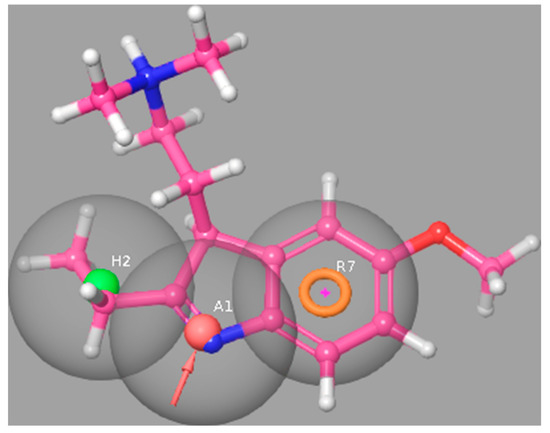
Figure 3.
5-HT6R ligand (CHEMBL267615, Ki = 16 nM) mapped to the pharmacophore model of the 5-HT6R ligands.
In order to strongly support the compound activity via molecular modeling approaches, docking studies were carried out in the next step (inactive-state homology model of 5-HT6R deposited in the GPCRdb [50] database was used, and the docking was carried out in Glide [51] from the Schrödinger Suite 2022). The models were created based on the GPCRdb homology modeling pipeline [52]. It uses a chimeric approach in which a single template is selected as a main template; however, the template is screened locally and when a better template for a particular protein region is found, it is used to model the respective protein fragment The example ligand-receptor complex obtained for CHEMBL267615 is presented in Figure 4.
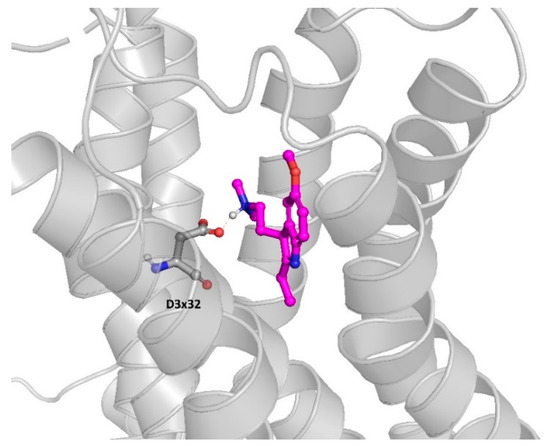
Figure 4.
5-HT6R ligand (CHEMBL267615) docked to the 5-HT6R homology model.
The compound presented in Figure 4 fits well in the 5-HT6R binding site, forming a number of hydrophobic and polar interactions. Most importantly, the charge-assisted hydrogen bond with the aspartic acid from the third transmembrane helix (D3x32 according to the GPCRdb numbering) is formed, but other important residues indicated as important to 5-HT6R activity also make contact with the compound, such as C3x36, S5x43, F6x51, F6x52, etc.
Additionally, the kinase inhibitors were docked to the 5-HT6R homology model in an analogous manner. The distribution of the docking score values for particular compound sets were examined (Figure 5, examples of docking poses are provided in the subsequent chapters).
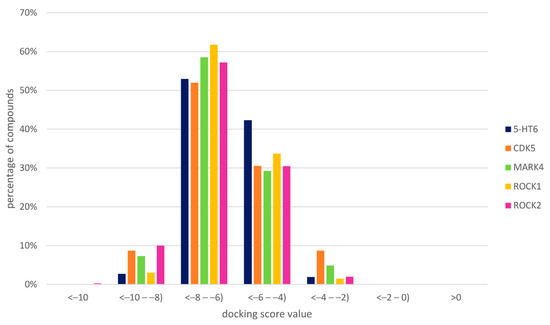
Figure 5.
Distribution of docking score values to 5-HT6R homology model.
The analysis of docking scores to 5-HT6R indicates that the distribution of their values is similar to both 5-HT6R ligands and ligands of the examined kinases. Although, the low docking score value does not guarantee the desired activity profile, its favorable value increases the probability of biding to the considered protein. For all ligand sets, the highest fraction of docking score values falls in the range of −8 to −6, and the second most populated group of values is between −6 and −4. CDK5, MARK4, ROCK I and ROCK II ligands possess a slightly higher fraction of compounds with a docking score between −4 and −2, but at the same time, for these targets, there is also a higher number of compounds with docking score values between −10 and −8 (in comparison to compounds active towards 5-HT6R).
In addition, the compounds were evaluated in terms of their ability to penetrate the blood–brain barrier. This was carried out via the determination of logP (calculations were performed in InstantJChem, https://chemaxon.com/products/instant-jchem [53]) for analogous compound sets, as in the case of docking. It was previously reported that logP values for the majority of drugs fall in the range of −0.5–6 [54]; however, the optimal logP range was set to 1.5–2.5 [55]. All the examined ligands fall in the similar logP distribution, with the majority of ligands adopting predicted logP values between 3 and 4 (Supplementary Materials Figure S1).
3. 5-HT6R/MARK4 as Dual Target Approach in Search for Therapeutic Solution against AD
Concerning the kinases, the mitogen-activated protein kinases (MAPKs) govern meaningful cellular programs and are crucial intermediate pathways in signaling, while microtubule affinity-regulating kinase 4 (MARK4) is a part of the kinases family recognized for actively phosphorylating neural microtubule-associated proteins (MAPs), i.e., MAP2, MAP4, and especially important for AD, tau protein. The kinase MARK4 is a member of the Ser/Thr kinase family and has been confirmed as a significant contributor in phosphorylating specific residues of tau, followed by its accumulation, and contributing in tauopathy. Phosphorylated tau also leads to neurofibrillary deposits and the formation of APP [56]. Tau phosphorylation effects are, therefore, correlated with neurodegeneration. Consequently, an overexpression of MARK4 is associated with numerous neurodegenerative disorders and neuropathy [57,58]. Thus, inhibiting MARK4 can be considered essential to cure some neurodegenerative diseases, including AD [59,60].
On the other hand, the highly important role of serotonin and 5-HT receptors in AD, particularly accented in the case of the 5-HT6R due to its unique function and CNS distributions, seems to be indisputable in light of the results of research conducted for over 20 years. Furthermore, recent lines of evidence, based on the fluorescence binding study, isothermal calorimetry, molecular docking and MD simulation studies for estimating the binding affinity and inhibiting potential of serotonin with MARK4, have demonstrated serotonin as an inhibitor of this important kinase. Hence, targeting MARK4 by serotonin opens a “new gate” in managing the clinical manifestations of neurodegenerative diseases such as AD and dementia [60].
In contrast to the 5-HTR-nonselective serotonin, selective 5-HT6R agents that also inhibit MARK4 would offer the possibility of a specific and better controlled pharmacological profile, thus guaranteeing more favorable therapeutic effects. In this context, the search for new structures of dual modulators of MARK4 and 5-HT6R gives new hope for a breakthrough in AD treatment, which is highly justified taking into account the signal transduction pathways at the cellular level. The question then arises as to whether it is possible to find these suitable double-agent structures from a chemical point of view.
Although lines of evidence indicate hundreds of 5-HT6R ligands with nanomolar affinities and different intrinsic profiles, the number of identified families of MARK4 inhibitors is much lower, and it is difficult to find any report on compounds simultaneously showing both MARK4 and 5-HT6R action in a high enough activity range. Among more than 100 dual MARK4/5-HT6R records in the CHEMBL database, none have been found to exhibit submicromolar effects for both purposes simultaneously. However, this state of the art does not seem to be associated with a distinct structural limitation but, more probably, with a lack of attention to this direction of research, until now.
Current lines of evidence show various chemical families of MARK4 inhibitors, estimated using different assays and activity descriptors, i.e., % inhibiting at concentrations of 1 µM or 10 µM, as well as IC50 or Kd. The compounds can be classified into the following activity categories: weak (IC50 in millimolar range), moderate (1 µM < IC50 < 1 mM) and potent MARK4 inhibitors (IC50 < 1 µM). In order to compare the activity expressed in various ways (IC50, Kd or %inhibition at a given concentration), a formal inhibition activity descriptor (FA) was used (Figure 6, Table S1 in Supplementary Materials).
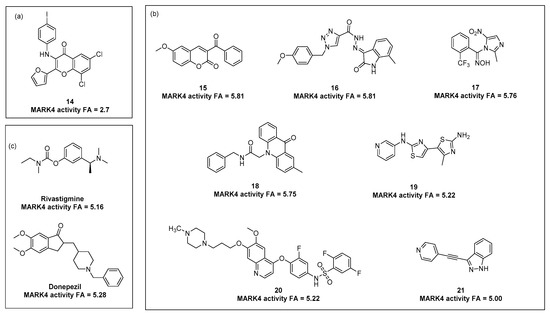
Figure 6.
Representatives of weak and moderate MARK4 inhibitors with the activity descriptors; (a) the weak 3-N-aryl substituted-2-heteroarylchromoneinhibitor 14 [54] in comparison to the moderate 3-benzoylcoumarinMARK4 inhibitor; (b) the moderate inhibitors from various heterocyclic families 15 [55], 16 [56], 17 [57], 18 [58], 19 [59], 20 [60], 21 [61]; (c) MARK4 inhibitory properties of rivastigmine and donepezil [50]. To compare the activity expressed in various ways (IC50, Kd or %inhibition at a given concentration), the formal inhibition activity descriptor (FA) was used, i.e.,: FA = pIC50 (IC50); FA = pKd (Kd), FA = p(test concentration/0.02 × %inhibition).
In 2018, Parveen et al. [61] described a series of novel 3-N-aryl substituted-2-heteroarylchromones with inhibitory properties toward MARK 4. Although the compounds displayed rather weak millimolar action, the results can be used for pharmacophore hypotheses in a wider structural consideration, and SAR analysis gave some valuable conclusions demonstrating the favorable role of moderate electro-withdrawing and lipophilic substituents (halogens) in both occurring aryl rings (14, Figure 6a).
A significant increase in activity was achieved through the replacement of the chromone core with a bioisosteric scaffold of 3-benzoylcoumarin substituted at the aromatic coumarin part. According to the studies described by Shen et al., the methoxy-substituent provides the most potent action with preferable position 6 compared to 8 (15, Figure 6b) to give inhibiting action at lower micromolar concentrations [62]. However, other lines of evidence indicate the wider chemical diversity of moderate MARK4 inhibitors with micromolar activities, including: derivatives of 1,2,3-triazole-4-carbohydrazide [63], imidazole oximes (17) [64], acridine derivatives (18) [65], pyridine derivative of dithiazole (19) [66], the extended structure of 2,5-difluoro-N-(3-fluoro-4-(6-methoxy-7-(3-(4-methylpiperazin-1-yl)propoxy)quinolin-4-yloxy)phenyl)benzenesulfonamide (20) [67] and the more condensed structure of 3-(2-(pyridin-4-yl)ethynyl)-1H-indazole (21) [68].
Interestingly, the studies of Shamsi et al. [57] demonstrated the moderate micromolar MARK4 inhibiting action for known AD drugs acting as AChE inhibitors, i.e., donepezil and rivastigmine; slightly more potent in the case of donepezil (Figure 6c).
The active MARK4 inhibitors, described with submicromolar to have a low-nanomolar range of action, contain the indispensable central core of the pyrimidine, which appears to be a required pharmacophore feature in interactions with this kinase, while a variety of the remaining substitutions enhances the inhibitory power [69,70,71,72,73,74]. The most active pyrimidine MARK4 inhibitors 22–28 (IC50 < 100 nM) are shown in Figure 7 [69,70,71,72,73].
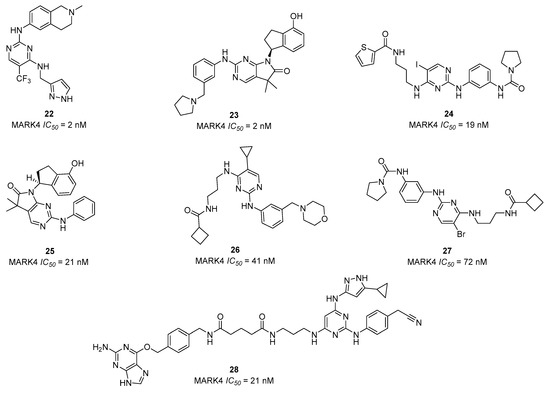
Figure 7.
The most potent MARK4 inhibitors (IC50 < 100 nM) 22 [62], 23, 24, 26 [63], 25 [64], 27 [65], 28 [66].
A qualitative structure-activity relationship (SAR) analysis of the potent MARK4 inhibitors (IC50 < 1 µM) indicates two general structures based on pyrimidine core (Figure 8, see also Table S1 in Supplementary Materials).
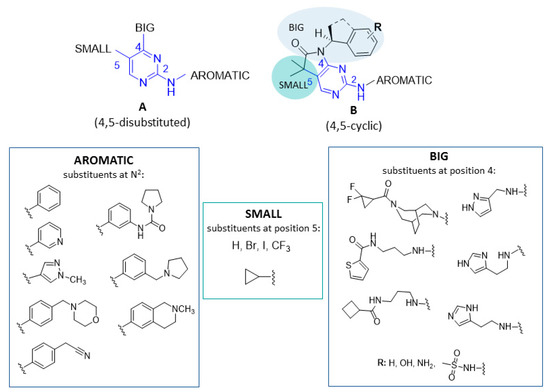
Figure 8.
General structures (A,B) of the potent MARK4 inhibitors (IC50 < 1 µM) described [14,15,16,17,18,19]. The common feature of pyrimidine 2,4,5-trisubstituted (A) or 2-substituted-4,5-cyclic (B) in blue, the favorable substituents in rectangular frames.
Both groups (A and B) include different aromatic substituents attached to the amine group in position 2 of the pyrimidine ring with benzylpyrrolidine and 2-methyl-1,2,3,4-tetrahydroisoquinoline in the most potent compounds.
Other crucial features in these structures are substituents at positions 4 and 5 of the pyrimidine ring, depending on these substituents, structures can be divided into 4,5-disubstituted (A) and 4,5-cyclic (B). The substituent at position 5 is small and lipophilic, while substituents occurring at position 4 are rather bigger and contain an amide group and/or a heteroaromatic ring. In the case of 4,5-disubstituted pyrimidines, trifluoromethyl, iodine, bromine and cyclopropane seem to be the most favorable small substituents at position 5, while in position 4, the best results were obtained for the amine group linked by different alkyl chains with pyrazole, thiophene-2-carboxamide or cyclobutene carboxamide. For the 4,5-cyclic pyrimidines, the pyrimidine is condensed with 3,3-dimethylpyrrolidin-2-one, with another moiety attached by nitrogen in the pyrrolidine ring. Two methyl groups function as a small substituent at position 5 and the amide group with attached moiety (2,3-dihydroindene or ethylbenzene derivatives) serves as the bigger substituent at position 4. Additionally, an electron rich substituent (amine, methylsulfonamide or hydroxyl group) at the phenyl ring in the big substituent positively influenced the MARK4 inhibitory action.
However, lines of evidence indicate one unique compound 28 (Figure 7), which, unlike other discussed structures, possesses a very big substituent at position 6 instead of the small substituent at position 5; however, it still presents very good activity (IC50 = 21 nM).
In order to examine possible dual MARK4/5-HT6R action, all potent MARK4 inhibitors 22–28 (Figure 7) were fitted to the pharmacophore model of 5-HT6R, and a docking study to the 5-HT6R homology model was carried out. The results for the most active inhibitors 23, 24 and 25 are shown in Figure 9.
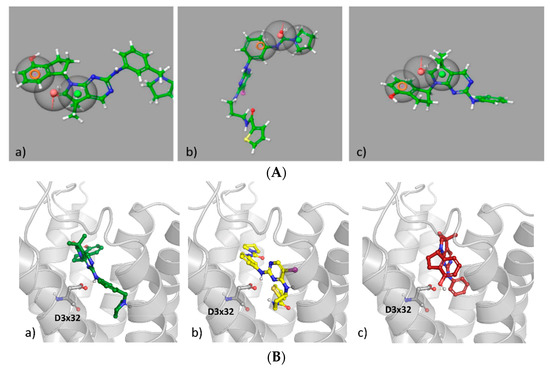
Figure 9.
Examples of the most active MARK4 inhibitors: (A) mapped on the 5-HT6R pharmacophore model; (B) docked to the homology model of 5-HT6R; (a) 23, (b) 24, (c) 25.
4. 5-HT6R/ROCKI/ROCKII as Multitarget Approach to AD Therapy
In 1995, Rho-associated coiled-coil-containing protein kinase, otherwise known as ROCK, was first identified and described as a major effector of RhoA [75]. This protein with a molecular mass of ~160 kDa belongs to the RhoA subfamily and the Ras GTPase superfamily with 25% homology to Ras [76]. Their structure comprises a N-terminally located catalytic Ser/Thr kinase domain, followed by a coiled-coil-forming region (~600 amino acids) with a Rho-binding domain (RBD) and a pleckstrin-homology (PH) domain with a cysteine-rich repeat at the C terminus [77]. Two mammalian isoforms of ROCK, ROCK I (ROCK-β, Rho-kinase β, or p160) encoded by a gene located on chromosome 18 and ROCK II (ROCK-α, p164) encoded by a gene located on chromosome 2, can be distinguished [78,79]. Despite a high structural similarity at approximately 65% overall amino acid identity and approximately 92% identity within the N-terminal kinase domain, these homologs have different locations in the body and, thus, different physiological functions have been identified for each [80].
In general, by phosphorylation of various molecular substrates, kinases ROCK are involved in many processes including cell contraction, adhesion, migration, growth, proliferation, inflammation, apoptosis and other various cellular functions [81]. Moreover, studies indicate that the activation of the RhoA/ROCK signaling pathway seems to induce Aβ aggregation [80], phosphorylated tau formation [82], neuroinflammation [83], synaptic damage [84], and other mechanisms, ultimately leading to AD [85].
Over the past decade, a whole host of structures have emerged as ROCK inhibitors for use in certain pathological conditions [86,87,88,89,90,91], including central nervous system diseases such as AD, Parkinson’s disease (PD) and Huntington’s disease (HD) [85,92,93]. So far, none have been sufficient for use in the treatment of neurodegenerative diseases. Furthermore, in the current literature, there are a lack of compounds with multitarget effects on ROCK and another dementia-related targets, such as 5-HT6R.
Inhibition of ROCK I/II kinases has become a dynamically developing trend in recent years, as evidenced by the huge number of compounds from various chemical classes. Among them, it is possible to distinguish compounds belonging to the following chemical groups: benzimidazole 29 [94], isoquinoline 30, bezylpiperidine-isoquinoline (31, 32) [95], pyridine (33, 34) [96,97], pyrazole (35) [98], indole, azaindole (36, 37) [99,100] amide-chroman derivatives [101], urea derivatives(40) [102], quinazoline (41) [103], indazole (42, 43) [104,105,106] and pyridopyrimidinone (44) [CHEMBL1988581] (Figure 10), as well as benzothiazole, benzathiophene, aminofurazane, and boron derivatives [107].
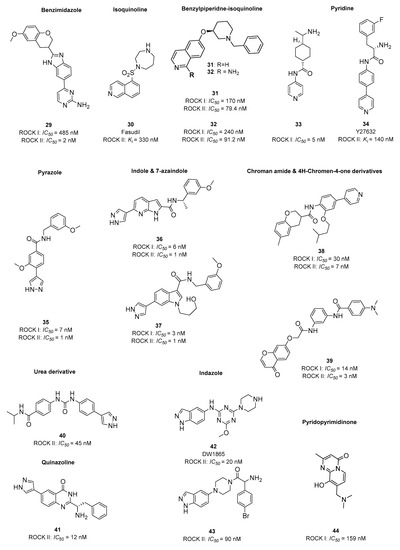
Figure 10.
Examples of potent ROCK inhibitors from different chemical classes: 29 [94], 31 [95], 32 [95], 33 [96], 34 [97], 35 [98], 36 [99], 37 [100], 40 [102], 41 [103], 42 [106], 43 [108], 44 [CHEMBL1988581]. ROCK inhibiting potency expressed with either IC50 or Ki values (nM).
One of the first and most important ROCK inhibitors was the isoquinoline derivative fasudil 30 [109], approved by the FDA for human use in 1995 in Japan for the treatment of cerebral vasospasm [110]. The compound is moderately potent with a Ki of 330 nM and its structure consists of an isoquinoline ring, linked via a sulfonic group to the homopiperazine ring. Based on the current literature, it is worth noting that the sulfone moiety is also found in a great amount of potent 5-HT6 ligands.
To date, fasudil, as well as its analogues, are the most investigated ROCK inhibitors. Many studies have shown that the compound improves memory deficits, significantly reduces Aβ and p-tau protein levels, restores cognitive function, reduces oxidative stress, and decreases neuronal apoptosis in the hippocampus [111,112,113,114].
The compound Y-27632 34 (Figure 10) and its analogues that have the aminopyridine core were synthesized by Yoshitomi Pharmaceuticals [115]. Moreover, compounds consisting of an aromatic ring directly attached at position 4 of the pyridine, azaindole, or pyrimidine already showed activity at the nanomolar level [97]. SAR analysis indicated that a large aromatic surface area hiding in the kinase active site and the additional presence of the NH moiety as hydrogen bond donors/acceptors significantly increases the inhibitory potency [116,117].
The indazole scaffold reported mainly by GlaxoSmithKline Pharmaceutical and Lee’s team has provided a number of compounds that can be considered potent inhibitors of ROCK I/II [104,105]. It should be noted that several essential 5-HT6 ligands, such as Cerlapirdine (2, Figure 1), developed by Pfizer, also contain a central core of the indazole [30]. In addition, many compounds in this chemical class have piperazine, 1,3,5-triazine [106] or 1,3-diazine (pyrimidine) moieties in their structure, which may also be a required pharmacophore feature of ROCK kinases. Importantly, these elements are a crucial structural feature of many 5-HT6 ligands, fitting into the current 5-HT6R pharmacophore.
The extensive literature used for this review also identified indole and 7-azaindole fused rings as structurally important moieties for both 5-HT6R ligands and ROCK I/II kinase inhibitors (Figure 11). All the structural similarities indicated above point to a real opportunity to create compounds with multitarget action on 5-HT6/ROCK I/II.
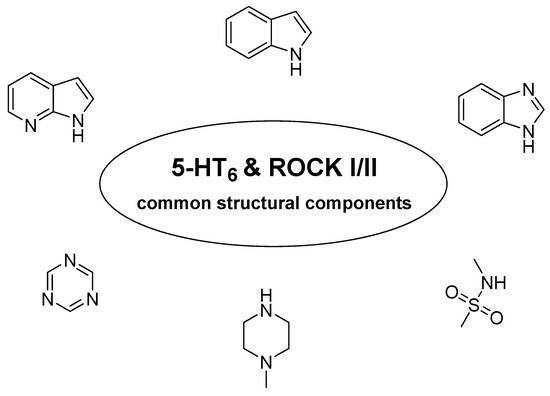
Figure 11.
Common structural elements found in 5-HT6R ligands and ROCK I/II inhibitors.
The potency of ROCK I and ROCK II inhibitors to also constitute good 5-HT6R ligands was tested in the following manner: all ROCK I and ROCK II data present in the ChEMBL database were filtered according to the activity values (Ki or IC50), which were supposed to be lower than 500 nM to consider the compound as active. There were 983 such inhibitors of ROCK I, and 1841 compounds inhibiting ROCK II. The majority of those ligands (80% and 76%, respectively) were successfully mapped on the 5-HT6R pharmacophore model, with example mappings presented for 31, 32 and 44 in Figure 12A.
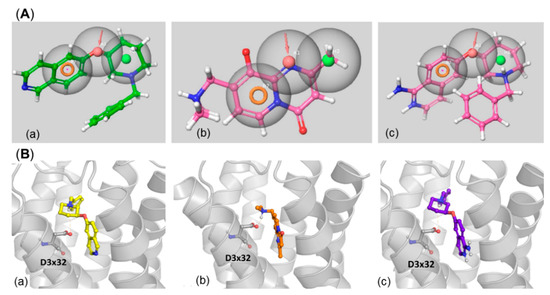
Figure 12.
Examples of ROCK I/ROCK II ligands: (A) mapped to the 5-HT6R pharmacophore model; (B) docked to homology model of 5-HT6R; (a) 31, (b) 44, (c) 32.
Analogously to the MARK4 inhibitors, the ROCK I and ROCK II ligands were also docked to the 5-HT6R homology model (Figure 12B).
Despite the correct fitting of the ligands to the pharmacophore model, they also form energy-preferable complexes with the 5-HT6R. All the compounds presented in Figure 12B form a hydrogen bond with D3x32 (31 and 32 via piperidine moiety, 44 via the amine part). 31–5HT6R complex possesses an additional hydrogen bond interaction between the primary amine group and A5x43. All the compounds also interact with 5-HT6R via pi-pi stacking with F6x52 (31 forms also pi-pi contact with F6x51).
5. 5-HT6R/CDK5 as Possible Dual Target Approach in Search for Innovative Therapy
First purified from bovine brain in 1992 [118], cyclin-dependent kinase 5 (CDK5) belongs to the family of proline-directed serine/threonine kinases and its gene is located on chromosome 7q36. The amino acids sequence of CDK5 is highly homologous to the sequence of other members of the CDKs family. In cells, it is responsible for various mechanisms including metabolic pathways, cell division and activation of transcriptional factors. To maintain its action, this kinase binds with unique activators such as p35 and p39 (expressed only in the CNS), the structure of which is more distinctive than typical CDKs. Structurally, the CDK5 protein consists of the N-terminus, C-terminus, ATP binding domain, activator binding domain, hinge region, PSSALRE helix and Tloop. Functions of the PSSALRE helix, Tloop, and ATP binding domain, which are essential for activation of CDK5, can be changed by different post-translational modifications (PTMs). Lines of evidence show that PTMs extend the functionality of the protein [119,120,121].
CDK5 in the human body can be found mainly in the central nervous system (CNS), where it participates in neuron migration, neurite overgrowth and synaptogenesis. Apart from CNS, CDK5 is also present in pancreatic β cells, corneal epithelial cells, and monocytes, where it is responsible for apoptosis, cell motility and cell cycle progression. Moreover, in previous years, CDK5 action was also proved to be associated with dopaminergic signaling, neurotransmitter release, and membrane cycling [122]. Concerning its mechanism of action, the aforementioned protein was suggested as a new therapeutic target for cancer [123,124,125], along with CNS diseases including AD, HD, stroke, and PD [126,127,128,129]. Increased activity of CDK5 is suggested as one of the causes of AD development. Dysregulation of this protein induces apoptosis of neuronal cells through various mechanisms, including Bcl-2, JNK3 and MEF2 [128].
Throughout the years, numerous different inhibitors with nanomolar affinity for CDK5 were discovered. Analyzing known inhibitors in the ChEMBL [130] database, three main chemical groups of the inhibitors (Figure 13) can be mentioned as follows: (i) cyclobutylthiazol-2-yl derivatives connected to either acetamide or urea (45, 46, 47, Figure 13a), (ii) 9-isopropyl-9H-purine derivatives (48, 49, Figure 13b) and (iii) 3-isopropyl-1H-pyrazolo [4,3-d] pyrimidine (50, 51, Figure 13c).
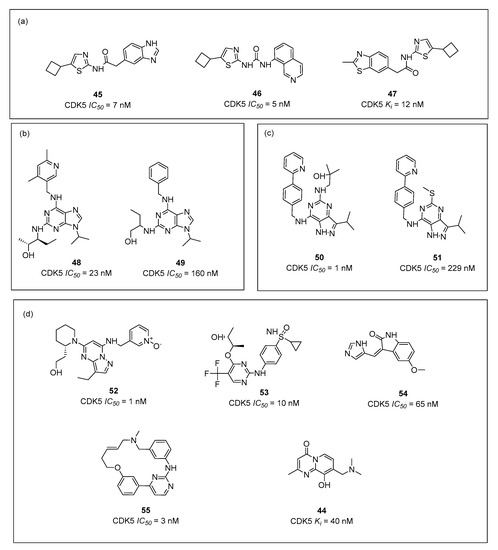
Figure 13.
Examples of inhibitors of CDK5 with their affinities (IC50 or Ki) within group (a–d) 45 [131], 46 [131], 47 [131], 48 [132], 49 [133], 50 [134], 51 [135], 52 [136], 53 [136], 54 [137], 55 [138], 44 (CHEMBL1988581).
Along other inhibitors (Figure 13d), chemical structures vary genuinely, including structures of pyrazolo[1,5-a]pyrimidine (52), 2-aminopyrimidine (53), indoline-2-on (54), macrocycles (55) pyridopyrimidinone (44) and many others.
The first main group represents 5-cyclobutylthiazol-2-yl derivatives, from which SAR showed that the heteroaromatic ring connected in the 2-amino position and a small hydrophobic substituent in the thiazole 5-position increased the selectivity and potency towards the CDK5. Thiazole moiety can also be found in a few antagonists of 5-HT6 receptor, e.g., 12 with Ki = 119 nM (Figure 1) [44].
Compounds containing 9-isopropyl-9H-purine scaffold (Figure 13b) having various hydroxyalkylamine substituents at the 5-position were shown to be the most potent within this group. As examples, highly potent reference kinase inhibitors: roscovitine, olomoucine and purvalanol A, may be mentioned. In a diverse compilation of 5-HT6 receptor antagonists, some of the structures (with nanomolar affinities towards 5-HT6R) can resemble the purine scaffold present in 48 and 49 (Figure 13b).
Structures within the third group (50 and 51, Figure 13c) include 3,5,7-trisubstituted pyrazolo[4,3-d]pyrimidine derivatives, in which several compounds showed very high kinase inhibiting potency (IC50 = 1 nM), introducing yet another scaffold in medicinal chemistry of CDKs inhibitors.
Importantly, several studies including X-ray and molecular modeling have indicated the pivotal role of cysteine (Cys83) in ligands binding to CDK5 in the ATP binding pocket [139,140]. This amino acid may be S-nitrosylated and, fascinatingly, the perturbation of such a process leads to the enhancement of dendrite development in cultured hippocampal neurons, which, of course, influences overall neuronal development [120]. Cys83, thanks to its characteristic structure, acts simultaneously as a hydrogen bond acceptor and donor. Hence, potent CDK5 inhibitors very often possess structural fragments that also consist of pairs, such as hydrogen bond acceptor and donor, placed closed to each other (Figure 14). Thus, it is possible to form two hydrogen bonds with the protein via interaction with Cys83 (Figure 14a) [141]. Interestingly, such chemical groups also occur in the structures of many 5-HT6R ligands, increasing the probability of their strong binding to CDK5 (Figure 14b).
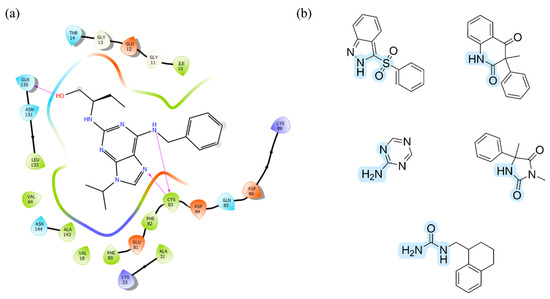
Figure 14.
(a) 2D protein-ligand interactions for roscovitine—strong CDK5 inhibitor (generated using Schrodinger Suite); (b) The examples of structural fragments of 5-HT6R ligands favorable for interactions with Cys83 in ATP binding pocket of CDK5.
Dozens of CDK5 inhibitors have reached clinical trials, mainly as therapeutics for various cancers. Dinaciclib (52, Figure 13d), for example, is currently undergoing phase 1 of the clinical trials for the treatment of breast cancer [142]. The most potent inhibitors reach the 1 nM affinity. Despite the huge number of highly active CDK5 agents, dual 5-HT6R/CDK5 continue to be an underexplored area of scientific research.
In terms of exploring the structural possibility for the desirable CDK5/5-HT6R dual action, the CDK5 ligands, which were filtered according to the same criteria as ROCK I and ROCK II compounds, formed the set of 263 compounds. Among them, 219 compounds were properly mapped to the 5-HT6R pharmacophore model, indicating their high potency for possessing a 5-HT6R activity component. Examples of three (56–58) out of 44 compounds, which were not mapped to the model, are presented in Figure 15.

Figure 15.
Examples of CDK5 ligands which were not successfully mapped to the 5-HT6R pharmacophore model.
In addition, the compounds were docked to the 5-HT6R homology model. Results for representatives (44 and 47) of both pharmacophore mapping and docking are presented in Figure 16.

Figure 16.
Examples of CDK5 ligands which were successfully mapped to the 5-HT6R pharmacophore model (A) together with their docking results (B); (a) 44, (b) 47.
Both ligands (44 and 47) are well aligned to the pharmacophore features of 5-HT6R ligands (Figure 16A). Compound 44, which has a smaller structure, is almost fully covered by the 5-HT6R pharmacophore model, in contrast to 47, for which quite a significant part of the molecule is outside of the model. Despite this extending part, 47 is very well fitted to the three considered features. Compound 47 also did not enter very deeply into the 5-HT6R binding site, rather it occupies its upper part (Figure 16B). Nevertheless, both compounds are strongly fitted in their ligand-protein complexes through the extended network of polar and hydrophobic contacts. Additionally, both 44 and 47 form hydrogen a bond with D3 × 32 and pi-pi interaction with a phenylalanine cluster from the 6th transmembrane helix of 5-HT6R.
6. Conclusions
As polypharmacology approaches may result in long-awaited breakthroughs in AD treatment, a computer-aided and visual analysis of the possibility of designing molecules with as yet unreported action via both 5-HT6R and the AD pathology-related kinase (MARK4, ROCKI/II or CDK5) within this paper has been performed. The deep insight into recent lines of evidence allowed us to identify the structural fragments that occur simultaneously in 5-HT6R agents and inhibitors of the considered above-mentioned kinases, as well as their appropriate bioisosteres. Interestingly, mapping the known kinase inhibitors to the 5-HT6R pharmacophore model showed the high potency of the majority of them to interact with the 5-HT6R. Hence, all potent pyrimidine-derived MARK4 inhibitors meet the 5-HT6R pharmacophore features criteria, as well as 80% of ROCKI, 76% of ROCKII and 83% of CDK5 ligands. Additionally, the results of docking to the 5-HT6R homology model confirmed the high probability of the investigated structures to form key interactions with this protein target. More than 60% of all four groups of the tested agents were docked with very good docking scores (values in the range between −10 and −6).
Summarizing, the overall analysis of the results from the pharmacophore-based and the docking-based (docking score values distribution) approaches indicated the high potency of inhibitors for all four investigated kinases to be also 5-HT6R antagonists. Furthermore, this very initial prediction of ADMET properties [143] for the most active kinase inhibitors that also fit in the 5-HT6R ligand pharmacophore features (23, 24, 25, 31, 32, 44 and 47) demonstrated rather a satisfactory profile for most of them, comparable to that of the reference drug, donepezil (see Table S2, Figure S1 in Supplementary Materials).
Such results give real hope for the design of structurally novel anti-AD agents with pioneering multifunctional (dual) action. Simultaneously, it seems to be strongly justified to test already reported 5-HT6R ligands in terms of potency to inhibit the investigated herein kinases, as well as to examine ADMET properties for the most promising dual-target agents found following this process.
Supplementary Materials
The supporting information can be downloaded at: https://www.mdpi.com/article/10.3390/ijms23158768/s1. References [61,62,63,64,65,66,67,68,69,70,71,72,73,143] are cited in the supplementary materials.
Author Contributions
Conceptualization, J.H., S.P., K.K.-B., K.C.-Ł.; methodology and investigation (molecular modelling), S.P.; writing—original draft preparation, K.C.-Ł., K.K-B., J.H., S.P., W.H., P.P.; writing—review and editing, K.C.-Ł., J.H., K.K-B., S.P., W.H.; supervision, J.H.; project administration, J.H.; funding acquisition, J.H.. All authors have read and agreed to the published version of the manuscript.
Funding
Partly supported by National Science Center (Poland) Grant No. UMO-2018/31/B/NZ7/02160.
Institutional Review Board Statement
Not applicable.
Informed Consent Statement
Not applicable.
Data Availability Statement
Not applicable.
Acknowledgments
S.P. is member of the COST Action CA 18133 “European Research Network on Signal Transduction—ERNEST”. P.P. and W.H. participated in the preparation of this manuscript within the Student Medicinal Chemistry Scientific Group at the Department of Technology and Biotechnology of Drugs, JU MC (Studenckie Koło Chemii Medycznej, UJCM).
Conflicts of Interest
The authors declare no conflict of interest.
References
- Blandr, J. Mild Cognitive Impairment, Neurodegeneration, and Personalized Lifestyle Medicine. Integr. Med. 2016, 15, 12–14. [Google Scholar]
- da Silva, E.R.; Rodrigues Menezes, I.R.; Brys, I. Effects of Transcranial Direct Current Stimulation on Memory of Elderly People with Mild Cognitive Impairment or Alzheimer’s Disease: A Systematic Review. J. Cent. Nerv. Syst. Dis. 2022, 14, 117957352211068. [Google Scholar] [CrossRef] [PubMed]
- García-Casares, N.; Fuentes, P.G.; Barbancho, M.Á.; López-Gigosos, R.; García-Rodríguez, A.; Gutiérrez-Bedmar, M. Alzheimer’s Disease, Mild Cognitive Impairment and Mediterranean Diet. A Systematic Review and Dose-Response Meta-Analysis. J. Clin. Med. 2021, 10, 4642. [Google Scholar] [CrossRef] [PubMed]
- Association, A. 2018 Alzheimer’s Disease Facts and Figures. Alzheimer’s Dement. 2018, 14, 367–429. [Google Scholar] [CrossRef]
- Zvěřová, M. Clinical Aspects of Alzheimer’s Disease. Clin. Biochem. 2019, 72, 3–6. [Google Scholar] [CrossRef]
- Srivastava, S.; Ahmad, R.; Khare, S.K. Alzheimer’s Disease and Its Treatment by Different Approaches: A Review. Eur. J. Med. Chem. 2021, 216, 113320. [Google Scholar] [CrossRef]
- Pardo-Moreno, T.; González-Acedo, A.; Rivas-Domínguez, A.; García-Morales, V.; García-Cozar, F.J.; Ramos-Rodríguez, J.J.; Melguizo-Rodríguez, L. Therapeutic Approach to Alzheimer’s Disease: Current Treatments and New Perspectives. Pharmaceutics 2022, 14, 1117. [Google Scholar] [CrossRef]
- Beshir, S.A.; Aadithsoorya, A.M.; Parveen, A.; Goh, S.S.L.; Hussain, N.; Menon, V.B. Aducanumab Therapy to Treat Alzheimer’s Disease: A Narrative Review. Int. J. Alzheimer’s Dis. 2022, 2022, 9343514. [Google Scholar] [CrossRef]
- Whitehouse, P.; Gandy, S.; Saini, V.; George, D.R.; Larson, E.B.; Alexander, G.C.; Avorn, J.; Brownlee, S.; Camp, C.; Chertkow, H.; et al. Making the Case for Accelerated Withdrawal of Aducanumab. J. Alzheimer’s Dis. 2022, 87, 1003–1007. [Google Scholar] [CrossRef]
- Gunawardena, I.P.C.; Retinasamy, T.; Shaikh, M.F. Is Aducanumab for LMICs? Promises and Challenges. Brain Sci. 2021, 11, 1547. [Google Scholar] [CrossRef]
- Karila, D.; Freret, T.; Bouet, V.; Boulouard, M.; Dallemagne, P.; Rochais, C. Therapeutic Potential of 5-HT6 Receptor Agonists. J. Med. Chem. 2015, 58, 7901–7912. [Google Scholar] [CrossRef] [PubMed]
- Benhamú, B.; Martín-Fontecha, M.; Vázquez-Villa, H.; Pardo, L.; López-Rodríguez, M.L. Serotonin 5-HT6receptor Antagonists for the Treatment of Cognitive Deficiency in Alzheimer’s Disease. J. Med. Chem. 2014, 57, 7160–7181. [Google Scholar] [CrossRef] [PubMed]
- Khoury, R.; Grysman, N.; Gold, J.; Patel, K.; Grossberg, G.T. The Role of 5 HT6-Receptor Antagonists in Alzheimer’s Disease: An Update. Expert Opin. Investig. Drugs 2018, 27, 523–533. [Google Scholar] [CrossRef] [PubMed]
- Kucwaj-Brysz, K.; Baltrukevich, H.; Czarnota, K.; Handzlik, J. Chemical Update on the Potential for Serotonin 5-HT6 and 5-HT7 Receptor Agents in the Treatment of Alzheimer’s Disease. Bioorg. Med. Chem. Lett. 2021, 49, 128275. [Google Scholar] [CrossRef]
- Ferrari, C.; Sorbi, S. The Complexity of Alzheimer’s Disease: An Evolving Puzzle. Physiol Rev. 2021, 101, 1047–1081. [Google Scholar] [CrossRef]
- Sampietro, A.; Pérez-Areales, F.J.; Martínez, P.; Arce, E.M.; Galdeano, C.; Muñoz-Torrero, D. Unveiling the Multitarget Anti-Alzheimer Drug Discovery Landscape: A Bibliometric Analysis. Pharmaceuticals 2022, 15, 545. [Google Scholar] [CrossRef]
- Zięba, A.; Stępnicki, P.; Matosiuk, D.; Kaczor, A.A. What Are the Challenges with Multi-Targeted Drug Design for Complex Diseases? Expert Opin. Drug Discov. 2022, 17, 673–683. [Google Scholar] [CrossRef]
- Kabir, A.; Muth, A. Polypharmacology: The Science of Multi-Targeting Molecules. Pharmacol. Res. 2022, 176, 106055. [Google Scholar] [CrossRef]
- Wiȩckowska, A.; Wichur, T.; Godyń, J.; Bucki, A.; Marcinkowska, M.; Siwek, A.; Wiȩckowski, K.; Zarȩba, P.; Knez, D.; Głuch-Lutwin, M.; et al. Novel Multitarget-Directed Ligands Aiming at Symptoms and Causes of Alzheimer’s Disease. ACS Chem. Neurosci. 2018, 9, 1195–1214. [Google Scholar] [CrossRef]
- Millan, M.J.; Dekeyne, A.; Gobert, A.; Brocco, M.; Mannoury la Cour, C.; Ortuno, J.C.; Watson, D.; Fone, K.C.F. Dual-Acting Agents for Improving Cognition and Real-World Function in Alzheimer’s Disease: Focus on 5-HT6 and D3 Receptors as Hubs. Neuropharmacology 2020, 177, 108099. [Google Scholar] [CrossRef]
- Yahiaoui, S.; Hamidouche, K.; Ballandonne, C.; Davis, A.; De Oliveira Santos, J.S.; Freret, T.; Boulouard, M.; Rochais, C.; Dallemagne, P. Design, Synthesis, and Pharmacological Evaluation of Multitarget-Directed Ligands with Both Serotonergic Subtype 4 Receptor (5-HT4R) Partial Agonist and 5-HT6R Antagonist Activities, as Potential Treatment of Alzheimer’s Disease. Eur. J. Med. Chem. 2016, 121, 283–293. [Google Scholar] [CrossRef]
- López-Rodríguez, M.L.; Benhamú, B.; de la Fuente, T.; Sanz, A.; Pardo, L.; Campillo, M. A Three-Dimensional Pharmacophore Model for 5-Hydroxytryptamine 6 (5-HT6) Receptor Antagonists. J. Med. Chem. 2005, 48, 4216–4219. [Google Scholar] [CrossRef]
- Nirogi, R.; Goyal, V.K.; Bhyrapuneni, G.; Palacharla, V.R.C.; Ravulu, J.; Jetta, S.; Jasti, V. Masupirdine in Combination with Donepezil and Memantine in Patients with Moderate Alzheimer’s Disease: Subgroup Analyses of Memantine Regimen, Plasma Concentrations and Duration of Treatment. Alzheimer’s Dement. 2020, 16, e039254. [Google Scholar] [CrossRef]
- Nirogi, R.; Jayarajan, P.; Shinde, A.K.; Abraham, R.; Goyal, V.K.; Benade, V.; Ravulu, J.; Jasti, V. Masupirdine (SUVN-502): Novel Treatment Option for the Management of Behavioral and Psychological Symptoms in Patients with Alzheimer’s Disease. Alzheimer’s Dement. 2020, 16, e039303. [Google Scholar] [CrossRef]
- Study Evaluating the Safety, Tolerability, PK and PD of SAM-531 in the Subjects with Mild to Moderate Alzheimer’s Disease. Available online: https://clinicaltrials.gov/ct2/show/NCT00481520 (accessed on 20 July 2022).
- Bezprozvanny, I. The Rise and Fall of Dimebon. Drug News Perspect. 2010, 23, 518. [Google Scholar] [CrossRef] [PubMed]
- Okun, I.; Tkachenko, S.; Khvat, A.; Mitkin, O.; Kazey, V.; Ivachtchenko, A. From Anti-Allergic to Anti-Alzheimer’s: Molecular Pharmacology of Dimebon™. Curr. Alzheimer Res. 2010, 7, 97–112. [Google Scholar] [CrossRef] [PubMed]
- Eckert, S.H.; Gaca, J.; Kolesova, N.; Friedland, K.; Eckert, G.P.; Muller, W.E. Mitochondrial Pharmacology of Dimebon (Latrepirdine) Calls for a New Look at Its Possible Therapeutic Potential in Alzheimer’s Disease. Aging Dis. 2018, 9, 729. [Google Scholar] [CrossRef]
- Chau, S.; Herrmann, N.; Ruthirakuhan, M.T.; Chen, J.J.; Lanctôt, K.L. Latrepirdine for Alzheimer’s Disease. Cochrane Database Syst. Rev. 2015, 4, CD009524. [Google Scholar] [CrossRef]
- Andrews, M.; Tousi, B.; Sabbagh, M.N. 5HT6 Antagonists in the Treatment of Alzheimer’s Dementia: Current Progress. Neurol. Ther. 2018, 7, 51–58. [Google Scholar] [CrossRef]
- Herrik, K.F.; Mørk, A.; Richard, N.; Bundgaard, C.; Bastlund, J.F.; de Jong, I.E.M. The 5-HT 6 Receptor Antagonist Idalopirdine Potentiates the Effects of Acetylcholinesterase Inhibition on Neuronal Network Oscillations and Extracellular Acetylcholine Levels in the Rat Dorsal Hippocampus. Neuropharmacology 2016, 107, 351–363. [Google Scholar] [CrossRef]
- Matsunaga, S.; Fujishiro, H.; Takechi, H. Efficacy and Safety of Idalopirdine for Alzheimer’s Disease: A Systematic Review and Meta-Analysis. Int. Psychogeriatr. 2019, 31, 1627–1633. [Google Scholar] [CrossRef] [PubMed]
- Harris, R.N., III; Kress, J.M.; Repke, D.B.; Stabler, R.S. Dibenzoxazepinone Derivatives as 5-HT6 and 5-HT2A Receptor Antagonists, Their Preparation, Pharmaceutical Compositions, and Use in Therapy. WO2006061126A2, 15 June 2006. [Google Scholar]
- Seong, C.M.; Park, W.K.; Park, C.M.; Kong, J.Y.; Park, N.S. Discovery of 3-Aryl-3-Methyl-1H-Quinoline-2,4-Diones as a New Class of Selective 5-HT6 Receptor Antagonists. Bioorg. Med. Chem. Lett. 2008, 18, 738–743. [Google Scholar] [CrossRef] [PubMed]
- Shahid, M.; Walker, G.; Zorn, S.; Wong, E. Asenapine: A Novel Psychopharmacologic Agent with a Unique Human Receptor Signature. J. Psychopharmacol. 2009, 23, 65–73. [Google Scholar] [CrossRef]
- Łażewska, D.; Kurczab, R.; Więcek, M.; Kamińska, K.; Satała, G.; Jastrzębska-Więsek, M.; Partyka, A.; Bojarski, A.J.; Wesołowska, A.; Kieć-Kononowicz, K.; et al. The Computer-Aided Discovery of Novel Family of the 5-HT6 Serotonin Receptor Ligands among Derivatives of 4-Benzyl-1,3,5-Triazine. Eur. J. Med. Chem. 2017, 135, 117–124. [Google Scholar] [CrossRef]
- Latacz, G.; Lubelska, A.; Jastrzębska-Więsek, M.; Partyka, A.; Marć, M.A.; Satała, G.; Wilczyńska, D.; Kotańska, M.; Więcek, M.; Kamińska, K.; et al. The 1,3,5-Triazine Derivatives as Innovative Chemical Family of 5-HT6 Serotonin Receptor Agents with Therapeutic Perspectives for Cognitive Impairment. Int. J. Mol. Sci. 2019, 20, 3420. [Google Scholar] [CrossRef] [PubMed]
- Sudoł, S.; Cios, A.; Jastrzębska-Więsek, M.; Honkisz-Orzechowska, E.; Mordyl, B.; Wilczyńska-Zawal, N.; Satała, G.; Kucwaj-Brysz, K.; Partyka, A.; Latacz, G.; et al. The Phenoxyalkyltriazine Antagonists for 5-HT6 Receptor with Promising Procognitive and Pharmacokinetic Properties In Vivo in Search for a Novel Therapeutic Approach to Dementia Diseases. Int. J. Mol. Sci. 2021, 22, 10773. [Google Scholar] [CrossRef]
- Sudoł, S.; Kucwaj-Brysz, K.; Kurczab, R.; Wilczyńska, N.; Jastrzębska-Więsek, M.; Satała, G.; Latacz, G.; Głuch-Lutwin, M.; Mordyl, B.; Żesławska, E.; et al. Chlorine Substituents and Linker Topology as Factors of 5-HT6R Activity for Novel Highly Active 1,3,5-Triazine Derivatives with Procognitive Properties in Vivo. Eur. J. Med. Chem. 2020, 203, 112529. [Google Scholar] [CrossRef] [PubMed]
- Lubelska, A.; Latacz, G.; Jastrzębska-Więsek, M.; Kotańska, M.; Kurczab, R.; Partyka, A.; Marć, M.A.; Wilczyńska, D.; Doroz-Płonka, A.; Łażewska, D.; et al. Are the Hydantoin-1,3,5-Triazine 5-HT6R Ligands a Hope to a Find New Procognitive and Anti-Obesity Drug? Considerations Based on Primary In Vivo Assays and ADME-Tox Profile In Vitro. Molecules 2019, 24, 4472. [Google Scholar] [CrossRef]
- Kurczab, R.; Ali, W.; Łażewska, D.; Kotańska, M.; Jastrzębska-Więsek, M.; Satała, G.; Więcek, M.; Lubelska, A.; Latacz, G.; Partyka, A.; et al. Computer-Aided Studies for Novel Arylhydantoin 1,3,5-Triazine Derivatives as 5-HT6 Serotonin Receptor Ligands with Antidepressive-Like, Anxiolytic and Antiobesity Action In Vivo. Molecules 2018, 23, 2529. [Google Scholar] [CrossRef]
- Vanda, D.; Soural, M.; Canale, V.; Chaumont-Dubel, S.; Satała, G.; Kos, T.; Funk, P.; Fülöpová, V.; Lemrová, B.; Koczurkiewicz, P.; et al. Novel Non-Sulfonamide 5-HT 6 Receptor Partial Inverse Agonist in a Group of Imidazo[4,5- b ]Pyridines with Cognition Enhancing Properties. Eur. J. Med. Chem. 2018, 144, 716–729. [Google Scholar] [CrossRef]
- Smusz, S.; Kurczab, R.; Satała, G.; Bojarski, A.J. Fingerprint-Based Consensus Virtual Screening towards Structurally New 5-HT6R Ligands. Bioorg. Med. Chem. Lett. 2015, 25, 1827–1830. [Google Scholar] [CrossRef] [PubMed]
- Harris, R.N.; Stabler, R.S.; Repke, D.B.; Kress, J.M.; Walker, K.A.; Martin, R.S.; Brothers, J.M.; Ilnicka, M.; Lee, S.W.; Mirzadegan, T. Highly Potent, Non-Basic 5-HT6 Ligands. Site Mutagenesis Evidence for a Second Binding Mode at 5-HT6 for Antagonism. Bioorg. Med. Chem. Lett. 2010, 20, 3436–3440. [Google Scholar] [CrossRef] [PubMed]
- Ivanenkov, Y.A.; Majouga, A.G.; Veselov, M.S.; Chufarova, N.V.; Baranovsky, S.S.; Filkov, G.I. Computational Approaches to the Design of Novel 5-HT6 R Ligands. Rev. Neurosci. 2014, 25, 451–467. [Google Scholar] [CrossRef] [PubMed]
- Huang, S.; Xu, P.; Shen, D.; Simon, I.A.; Mao, C.; Tan, Y.; Zhang, H.; Harpsøe, K.; Li, H.; Zhang, Y.; et al. GPCRs Steer Gi and Gs Selectivity via TM5-TM6 Switches as Revealed by Structures of Serotonin Receptors. Mol. Cell 2022, 82, 2681–2695.e6. [Google Scholar] [CrossRef] [PubMed]
- Gaulton, A.; Bellis, L.J.; Bento, A.P.; Chambers, J.; Davies, M.; Hersey, A.; Light, Y.; McGlinchey, S.; Michalovich, D.; Al-Lazikani, B.; et al. ChEMBL: A Large-Scale Bioactivity Database for Drug Discovery. Nucleic Acids Res. 2012, 40, D1100–D1107. [Google Scholar] [CrossRef]
- Bender, A.; Mussa, H.Y.; Glen, R.C.; Reiling, S. Similarity Searching of Chemical Databases Using Atom Environment Descriptors (MOLPRINT 2D): Evaluation of Performance. J. Chem. Inf. Comput. Sci. 2004, 44, 1708–1718. [Google Scholar] [CrossRef]
- Dixon, S.L.; Smondyrev, A.M.; Knoll, E.H.; Rao, S.N.; Shaw, D.E.; Friesner, R.A. PHASE: A New Engine for Pharmacophore Perception, 3D QSAR Model Development, and 3D Database Screening: 1. Methodology and Preliminary Results. J. Comput.–Aided Mol. Des. 2006, 20, 647–671. [Google Scholar] [CrossRef]
- Pándy-Szekeres, G.; Esguerra, M.; Hauser, A.S.; Caroli, J.; Munk, C.; Pilger, S.; Keserű, G.M.; Kooistra, A.J.; Gloriam, D.E. The G protein database, GproteinDb. Nucleic Acids Res. 2022, 50, D518–D525. [Google Scholar] [CrossRef]
- Friesner, R.A.; Murphy, R.B.; Repasky, M.P.; Frye, L.L.; Greenwood, J.R.; Halgren, T.A.; Sanschagrin, P.C.; Mainz, D.T. Extra Precision Glide: Docking and Scoring Incorporating a Model of Hydrophobic Enclosure for Protein-Ligand Complexes. J. Med. Chem. 2006, 49, 6177–6196. [Google Scholar] [CrossRef]
- Pándy-Szekeres, G.; Munk, C.; Tsonkov, T.M.; Mordalski, S.; Harpsøe, K.; Hauser, A.S.; Bojarski, A.J.; Gloriam, D.E. GPCRdb in 2018: Adding GPCR Structure Models and Ligands. Nucleic Acids Res. 2018, 46, D440–D446. [Google Scholar] [CrossRef]
- Potemkin, V.; Potemkin, A.; Grishina, M. Internet Resources for Drug Discovery and Design. Curr. Top Med. Chem. 2018, 18, 1955–1975. [Google Scholar] [CrossRef] [PubMed]
- Begley, D.J. Delivery of Therapeutic Agents to the Central Nervous System: The Problems and the Possibilities. Pharmacol. Ther. 2004, 104, 29–45. [Google Scholar] [CrossRef] [PubMed]
- Misra, A.; Ganesh, S.; Shahiwala, A.; Shah, S.P. Drug delivery to the central nervous system: A review. J. Pharm. Pharm. Sci. 2003, 6, 252–273. [Google Scholar]
- Sun, W.; Lee, S.; Huang, X.; Liu, S.; Inayathullah, M.; Kim, K.M.; Tang, H.; Ashford, J.W.; Rajadas, J. Attenuation of Synaptic Toxicity and MARK4/PAR1-Mediated Tau Phosphorylation by Methylene Blue for Alzheimer’s Disease Treatment. Sci. Rep. 2016, 6, 34784. [Google Scholar] [CrossRef] [PubMed]
- Shamsi, A.; Anwar, S.; Mohammad, T.; Alajmi, M.F.; Hussain, A.; Rehman, M.T.; Hasan, G.M.; Islam, A.; Hassan, M.I. MARK4 Inhibited by AChE Inhibitors, Donepezil and Rivastigmine Tartrate: Insights into Alzheimer’s Disease Therapy. Biomolecules 2020, 10, 789. [Google Scholar] [CrossRef] [PubMed]
- Lund, H.; Gustafsson, E.; Svensson, A.; Nilsson, M.; Berg, M.; Sunnemark, D.; von Euler, G. MARK4 and MARK3 Associate with Early Tau Phosphorylation in Alzheimer’s Disease Granulovacuolar Degeneration Bodies. Acta Neuropathol. Commun. 2014, 2, 22. [Google Scholar] [CrossRef]
- Anand, K.; Abdul, N.S.; Ghazi, T.; Ramesh, M.; Gupta, G.; Tambuwala, M.M.; Dureja, H.; Singh, S.K.; Chellappan, D.K.; Dua, K.; et al. Induction of Caspase-Mediated Apoptosis in HepG2 Liver Carcinoma Cells Using Mutagen–Antioxidant Conjugated Self-Assembled Novel Carbazole Nanoparticles and In Silico Modeling Studies. ACS Omega 2021, 6, 265–277. [Google Scholar] [CrossRef]
- Shamsi, A.; DasGupta, D.; Alhumaydhi, F.A.; Khan, M.S.; Alsagaby, S.A.; al Abdulmonem, W.; Hassan, M.I.; Yadav, D.K. Inhibition of MARK4 by Serotonin as an Attractive Therapeutic Approach to Combat Alzheimer’s Disease and Neuroinflammation. RSC Med. Chem. 2022, 13, 737–745. [Google Scholar] [CrossRef]
- Parveen, I.; Khan, P.; Ali, S.; Hassan, M.I.; Ahmed, N. Synthesis, Molecular Docking and Inhibition Studies of Novel 3-N-Aryl Substituted-2-Heteroarylchromones Targeting Microtubule Affinity Regulating Kinase 4 Inhibitors. Eur. J. Med. Chem. 2018, 159, 166–177. [Google Scholar] [CrossRef]
- Shen, X.; Liu, X.; Wan, S.; Fan, X.; He, H.; Wei, R.; Pu, W.; Peng, Y.; Wang, C. Discovery of Coumarin as Microtubule Affinity-Regulating Kinase 4 Inhibitor That Sensitize Hepatocellular Carcinoma to Paclitaxel. Front. Chem. 2019, 7, 366. [Google Scholar] [CrossRef]
- Aneja, B.; Khan, N.S.; Khan, P.; Queen, A.; Hussain, A.; Rehman, M.T.; Alajmi, M.F.; El-Seedi, H.R.; Ali, S.; Hassan, M.I.; et al. Design and Development of Isatin-Triazole Hydrazones as Potential Inhibitors of Microtubule Affinity-Regulating Kinase 4 for the Therapeutic Management of Cell Proliferation and Metastasis. Eur. J. Med. Chem. 2019, 163, 840–852. [Google Scholar] [CrossRef] [PubMed]
- Peerzada, M.N.; Khan, P.; Khan, N.S.; Avecilla, F.; Siddiqui, S.M.; Hassan, M.I.; Azam, A. Design and Development of Small-Molecule Arylaldoxime/5-Nitroimidazole Hybrids as Potent Inhibitors of MARK4: A Promising Approach for Target-Based Cancer Therapy. ACS Omega 2020, 5, 22759–22771. [Google Scholar] [CrossRef] [PubMed]
- Voura, M.; Khan, P.; Thysiadis, S.; Katsamakas, S.; Queen, A.; Hasan, G.M.; Ali, S.; Sarli, V.; Hassan, M.I. Probing the Inhibition of Microtubule Affinity Regulating Kinase 4 by N-Substituted Acridones. Sci. Rep. 2019, 9, 1676. [Google Scholar] [CrossRef] [PubMed]
- Ngoei, K.R.W.; Ng, D.C.H.; Gooley, P.R.; Fairlie, D.P.; Stoermer, M.J.; Bogoyevitch, M.A. Identification and Characterization of Bi-Thiazole-2,2′-Diamines as Kinase Inhibitory Scaffolds. Biochim. Biophys. Acta (BBA) Proteins Proteom. 2013, 1834, 1077–1088. [Google Scholar] [CrossRef] [PubMed]
- Szabadkai, I.; Torka, R.; Garamvölgyi, R.; Baska, F.; Gyulavári, P.; Boros, S.; Illyés, E.; Choidas, A.; Ullrich, A.; Őrfi, L. Discovery of N-[4-(Quinolin-4-Yloxy)Phenyl]Benzenesulfonamides as Novel AXL Kinase Inhibitors. J. Med. Chem. 2018, 61, 6277–6292. [Google Scholar] [CrossRef]
- Barile, E.; De, S.K.; Carlson, C.B.; Chen, V.; Knutzen, C.; Riel-Mehan, M.; Yang, L.; Dahl, R.; Chiang, G.; Pellecchia, M. Design, Synthesis, and Structure−Activity Relationships of 3-Ethynyl-1H-Indazoles as Inhibitors of the Phosphatidylinositol 3-Kinase Signaling Pathway. J. Med. Chem. 2010, 53, 8368–8375. [Google Scholar] [CrossRef]
- Li, F.; Liu, Z.; Sun, H.; Li, C.; Wang, W.; Ye, L.; Yan, C.; Tian, J.; Wang, H. PCC0208017, a Novel Small-Molecule Inhibitor of MARK3/MARK4, Suppresses Glioma Progression In Vitro and In Vivo. Acta Pharm. Sin. B 2020, 10, 289–300. [Google Scholar] [CrossRef]
- Faisal, M.; Kim, J.H.; Yoo, K.H.; Roh, E.J.; Hong, S.S.; Lee, S.H. Development and Therapeutic Potential of NUAKs Inhibitors. J. Med. Chem. 2021, 64, 2–25. [Google Scholar] [CrossRef]
- Katz, J.D.; Haidle, A.; Childers, K.K.; Zabierek, A.A.; Jewell, J.P.; Hou, Y.; Altman, M.D.; Szewczak, A.; Chen, D.; Harsch, A.; et al. Structure Guided Design of a Series of Selective Pyrrolopyrimidinone MARK Inhibitors. Bioorg. Med. Chem. Lett. 2017, 27, 114–120. [Google Scholar] [CrossRef]
- Drewry, D.H.; Annor-Gyamfi, J.K.; Wells, C.I.; Pickett, J.E.; Dederer, V.; Preuss, F.; Mathea, S.; Axtman, A.D. Identification of Pyrimidine-Based Lead Compounds for Understudied Kinases Implicated in Driving Neurodegeneration. J. Med. Chem. 2022, 65, 1313–1328. [Google Scholar] [CrossRef]
- Gower, C.M.; Thomas, J.R.; Harrington, E.; Murphy, J.; Chang, M.E.K.; Cornella-Taracido, I.; Jain, R.K.; Schirle, M.; Maly, D.J. Conversion of a Single Polypharmacological Agent into Selective Bivalent Inhibitors of Intracellular Kinase Activity. ACS Chem. Biol. 2016, 11, 121–131. [Google Scholar] [CrossRef] [PubMed]
- Fensome, A.; Ambler, C.M.; Arnold, E.; Banker, M.E.; Brown, M.F.; Chrencik, J.; Clark, J.D.; Dowty, M.E.; Efremov, I.V.; Flick, A.; et al. Dual Inhibition of TYK2 and JAK1 for the Treatment of Autoimmune Diseases: Discovery of ((S)-2,2-Difluorocyclopropyl)((1R,5S)-3-(2-((1-Methyl-1H-Pyrazol-4-Yl)Amino)Pyrimidin-4-Yl)-3,8-Diazabicyclo[3.2.1]Octan-8-Yl)Methanone (PF-06700841). J. Med. Chem. 2018, 61, 8597–8612. [Google Scholar] [CrossRef] [PubMed]
- Leung, T.; Manser, E.; Tan, L.; Lim, L. A Novel Serine/Threonine Kinase Binding the Ras-Related RhoA GTPase Which Translocates the Kinase to Peripheral Membranes. J. Biol. Chem. 1995, 270, 29051–29054. [Google Scholar] [CrossRef] [PubMed]
- Sharma, P.; Roy, K. ROCK-2-Selective Targeting and Its Therapeutic Outcomes. Drug Discov. Today 2020, 20, 446–455. [Google Scholar] [CrossRef] [PubMed]
- Ishizaki, T.; Maekawa, M.; Fujisawa, K.; Okawa, K.; Iwamatsu, A.; Fujita, A.; Watanabe, N.; Saito, Y.; Kakizuka, A.; Morii, N.; et al. The Small GTP-Binding Protein Rho Binds to and Activates a 160 KDa Ser/Thr Protein Kinase Homologous to Myotonic Dystrophy Kinase. EMBO J. 1996, 15, 1885–1893. [Google Scholar] [CrossRef]
- Nakagawa, O.; Fujisawa, K.; Ishizaki, T.; Saito, Y.; Nakao, K. ROCK-I and ROCK-II, Two Isoforms of Rho-Associated Coiled-Coil Forming Protein Serine / Threonine Kinase in Mice. FEBS Lett. 1996, 392, 189–193. [Google Scholar] [CrossRef]
- Matsui, T.; Amano, M.; Yamamoto, T.; Chihara, K.; Nakafuku, M.; Ito, M.; Nakano, T.; Okawa, K.; Iwamatsu, A.; Kaibuchi, K. Rho-Associated Kinase, a Novel Serine/Threonine Kinase, as a Putative Target for the Small GTP Binding Protein Rho. EMBO J. 1996, 15, 2208–2216. [Google Scholar] [CrossRef]
- Mueller, B.K.; Mack, H.; Teusch, N. Rho Kinase, A Promising Neurological Disorders. Nat. Rev. Drug Discov. 2005, 4, 387–398. [Google Scholar] [CrossRef]
- Shahbazi, R.; Baradaran, B.; Khordadmehr, M.; Safaei, S.; Baghbanzadeh, A.; Jigari, F.; Ezzati, H. Targeting ROCK Signaling in Health, Malignant and Non-Malignant Diseases. Immunol. Lett. 2020, 219, 15–26. [Google Scholar] [CrossRef]
- Gu, Q.F.; Yu, J.Z.; Wu, H.; Li, Y.H.; Liu, C.Y.; Feng, L.; Zhang, G.X.; Xiao, B.G.; Ma, C.G. Therapeutic Effect of Rho Kinase Inhibitor FSD–C10 in a Mouse Model of Alzheimer’s Disease. Exp. Ther. Med. 2018, 16, 3929–3938. [Google Scholar] [CrossRef]
- Chen, J.; Sun, Z.; Jin, M.; Tu, Y.; Wang, S.; Yang, X.; Chen, Q.; Zhang, X.; Han, Y.; Pi, R. Inhibition of AGEs/RAGE/Rho/ROCK Pathway Suppresses Non-Specific Neuroinflammation by Regulating BV2 Microglial M1/M2 Polarization through the NF-ΚB Pathway. J. Neuroimmunol. 2017, 305, 108–114. [Google Scholar] [CrossRef] [PubMed]
- Koch, J.C.; Tatenhorst, L.; Roser, A.E.; Saal, K.A.; Tönges, L.; Lingor, P. ROCK Inhibition in Models of Neurodegeneration and Its Potential for Clinical Translation. Pharmacol. Ther. 2018, 189, 1–21. [Google Scholar] [CrossRef] [PubMed]
- Cai, R.L.; Wang, Y.Y.; Huang, Z.T.; Zou, Q.; Pu, Y.S.; Yu, C.; Cai, Z. Role of RhoA/ROCK Signaling in Alzheimer’s Disease. Behav. Brain Res. 2021, 414, 113481. [Google Scholar] [CrossRef]
- Zhou, H.; Li, Y. Rho Kinase Inhibitors: Potential Treatments for Diabetes and Diabetic Complications. Curr. Pharm. Des. 2012, 18, 2964–2973. [Google Scholar] [CrossRef]
- Morgan-fisher, M.; Wewer, U.M.; Yoneda, A. Regulation of ROCK Activity in Cancer. J. Histochem. Cytochem. 2013, 61, 185–198. [Google Scholar] [CrossRef]
- Berrino, E.; Supuran, C.T. Expert Opinion on Therapeutic Patents Rho-Kinase Inhibitors in the Management of Glaucoma. Expert Opin. Ther. Patients 2019, 29, 817–827. [Google Scholar] [CrossRef] [PubMed]
- Urol, N.R. Understanding and Targeting the Rho Kinase Pathway in Erectile Dysfunction. Nat. Rev. Urol. 2015, 11, 622–628. [Google Scholar] [CrossRef]
- Ohnaka, K.; Shimoda, S.; Nawata, H.; Shimokawa, H.; Kaibuchi, K.; Iwamoto, Y.; Takayanagi, R. Pitavastatin Enhanced BMP-2 and Osteocalcin Expression by Inhibition of Rho-Associated Kinase in Human Osteoblasts. Biochem. Biophys. Res. Commun. 2001, 342, 337–342. [Google Scholar] [CrossRef]
- Satoh, K.; Fukumoto, Y.; Shimokawa, H. Rho-Kinase: Important New Therapeutic Target in Cardiovascular Diseases. Am. J. Physiol.-Heart Circ. Physiol. 2022, 301, H287–H296. [Google Scholar] [CrossRef]
- Amigoni, F.; Legnaghi, E.; Pevarello, P. Kinase Inhibitors for CNS Diseases: An Lysis of the Recent Patent Literature. Pharm. Pat. Anal 2012, 1, 177–192. [Google Scholar] [CrossRef]
- Julian, L.; Olson, M.F. Rho-Associated Coiled-Coil Containing Kinases (ROCK) Structure, Regulation, and Functions. Small GTPases 2014, 5, e29846. [Google Scholar] [CrossRef] [PubMed]
- Sessions, E.H.; Yin, Y.; Bannister, T.D.; Weiser, A.; Griffin, E.; Pocas, J.; Cameron, M.D.; Ruiz, C.; Lin, L.; Schürer, S.C.; et al. Benzimidazole- and Benzoxazole-Based Inhibitors of Rho Kinase. Bioorg. Med. Chem. Lett. 2008, 18, 6390–6393. [Google Scholar] [CrossRef]
- Ray, P.; Wright, J.; Adam, J.; Bennett, J.; Boucharens, S.; Black, D.; Cook, A.; Brown, A.R.; Epemolu, O.; Fletcher, D.; et al. Fragment-Based Discovery of 6-Substituted Isoquinolin-1-Amine Based ROCK-I Inhibitors. Bioorg. Med. Chem. Lett. 2011, 21, 97–101. [Google Scholar] [CrossRef]
- Activation, R.; Uehata, M.; Ishizaki, T.; Satoh, H. Calcium Sensitization of Smooth Muscle Mediated by a Rho-Associated Protein Kinase in Hypertension. Nature 1997, 389, 6654. [Google Scholar]
- Feng, Y.; Lograsso, P.V.; Defert, O.; Li, R. Rho Kinase (ROCK) Inhibitors and Their Therapeutic Potential. J. Med. Chem. 2016, 59, 2269–2300. [Google Scholar] [CrossRef] [PubMed]
- Chowdhury, S.; Sessions, E.H.; Pocas, J.R.; Grant, W.; Schröter, T.; Lin, L.; Ruiz, C.; Cameron, M.D.; Schürer, S.; Lograsso, P.; et al. Discovery and Optimization of Indoles and 7-Azaindoles as Rho Kinase (ROCK) Inhibitors (Part-I). Bioorg. Med. Chem. Lett. 2011, 21, 7107–7112. [Google Scholar] [CrossRef] [PubMed]
- Hu, Z.; Wang, C.; Glunz, P.W.; Li, J.; Cheadle, N.L.; Chen, A.Y.; Chen, X.Q.; Myers, J.E.; Guarino, V.R.; Rose, A.; et al. Discovery of a phenylpyrazole amide ROCK inhibitor as a tool molecule for in vivo studies. Bioorg. Med. Chem. Lett. 2020, 30, 127495. [Google Scholar] [CrossRef]
- Sessions, E.H.; Chowdhury, S.; Yin, Y.; Pocas, J.R.; Grant, W.; Schröter, T.; Lin, L.; Ruiz, C.; Cameron, M.D.; Lograsso, P.; et al. Bioorganic & Medicinal Chemistry Letters Discovery and Optimization of Indole and 7-Azaindoles as Rho Kinase (ROCK) Inhibitors (Part-II). Bioorg. Med. Chem. Lett. 2011, 21, 7113–7118. [Google Scholar] [CrossRef]
- Pan, J.; Yin, Y.; Zhao, L.; Feng, Y. Discovery of (S)-6-Methoxy-Chroman-3-Carboxylic Acid (4-Pyridin-4-Yl-Phenyl)-Amide as Potent and Isoform Selective ROCK2 Inhibitors. Bioorg. Med. Chem. 2019, 27, 1382–1390. [Google Scholar] [CrossRef]
- Yin, Y.; Zheng, K.; Eid, N.; Howard, S.; Jeong, J.; Yi, F.; Guo, J.; Park, C.M.; Bibian, M.; Wu, W.; et al. Bis-Aryl Urea Derivatives as Potent and Selective LIM Kinase (Limk) Inhibitors. J. Med. Chem. 2016, 58, 1846–1861. [Google Scholar] [CrossRef]
- Chowdhury, S.; Ting, Y.; Fang, X.; Grant, W.; Pocas, J.; Cameron, M.D.; Ruiz, C.; Lin, L.; Park, H.; Schröter, T.; et al. Amino Acid Derived Quinazolines as Rock / PKA Inhibitors. Bioorg. Med. Chem. Lett. 2013, 23, 1592–1599. [Google Scholar] [CrossRef] [PubMed]
- Sehon, C.A.; Wang, G.Z.; Viet, A.Q.; Goodman, K.B.; Dowdell, S.E.; Elkins, P.A.; Semus, S.F.; Evans, C.; Jolivette, L.J.; Kirkpatrick, R.B.; et al. Potent, Selective and Orally Bioavailable Dihydropyrimidine Inhibitors of Rho Kinase (ROCK1) as Potential Therapeutic Agents for Cardiovascular Diseases. J. Med. Chem. 2008, 51, 6631–6634. [Google Scholar] [CrossRef] [PubMed]
- Goodman, K.B.; Cui, H.; Dowdell, S.E.; Gaitanopoulos, D.E.; Ivy, R.L.; Sehon, C.A.; Stavenger, R.A.; Wang, G.Z.; Viet, A.Q.; Xu, W.; et al. Development of Dihydropyridone Indazole Amides as Selective Rho-Kinase Inhibitors. J. Med. Chem. 2007, 50, 6–9. [Google Scholar] [CrossRef]
- Oh, K.; Koo, B.; Ho, C.; Won, H.; Sook, N.; Hyun, J.; Soo, J.; Ho, B. Cardiovascular Effects of a Novel Selective Rho Kinase Inhibitor, 2- (1H-Indazole-5-Yl) Amino-4-Methoxy-6-Piperazino Triazine (DW1865). Eur. J. Pharmacol. 2013, 702, 218–226. [Google Scholar] [CrossRef] [PubMed]
- Dayal, N.; Mikek, C.G.; Hernandez, D.; Naclerio, G.A.; Fei, E.; Chu, Y.; Carter-cooper, B.A.; Lapidus, R.G.; Sintim, H.O. Potently Inhibiting Cancer Cell Migration with Novel 3H-Pyrazolo[4,3-f]Quinoline Boronic Acid ROCK Inhibitors. Eur. J. Med. Chem. 2019, 180, 449–456. [Google Scholar] [CrossRef] [PubMed]
- Feng, Y.; Cameron, M.D.; Frackowiak, B.; Griffin, E.; Lin, L.; Ruiz, C.; Schröter, T.; LoGrasso, P. Structure-Activity Relationships, and Drug Metabolism and Pharmacokinetic Properties for Indazole Piperazine and Indazole Piperidine Inhibitors of ROCK-II. Bioorg. Med. Chem. Lett. 2007, 17, 2355–2360. [Google Scholar] [CrossRef] [PubMed]
- Takayasu, M.; Suzuki, Y.; Shibuya, M.; Asano, T.; Kanamori, M.; Okada, T.; Kageyama, N.; Hidaka, H. The Effects of HA Compound Calcium Antagonists on Delayed Cerebral Vasospasm in Dogs. J. Neurosurg. 1986, 65, 80–85. [Google Scholar] [CrossRef]
- Liao, J.K.; Seto, M.; Noma, K. Rho Kinase (ROCK) Inhibitors. J. Cardiovasc. Pharmacol. 2007, 50, 17–24. [Google Scholar] [CrossRef]
- Hamano, T.; Shirafuji, N.; Yen, S.; Yoshida, H.; Nicholas, M.; Hayashi, K.; Ikawa, M.; Yamamura, O.; Fujita, Y.; Nakamoto, Y.; et al. Rho-Kinase ROCK Inhibitors Reduce Oligomeric Tau Protein. Neurobiol. Aging 2021, 89, 41–54. [Google Scholar] [CrossRef]
- Wei, W.; Wang, Y.; Zhang, J.; Gu, Q.; Liu, X.; Song, L.; Chai, Z.; Guo, M.; Yu, J.; Ma, C. Fasudil Ameliorates Cognitive Deficits, Oxidative Stress and Neuronal Apoptosis via Inhibiting ROCK/MAPK and Activating Nrf2 Signalling Pathways in APP/PS1 Mice. Folia Neuropathol. 2021, 59, 32–49. [Google Scholar] [CrossRef]
- Yan, H.; Yan, Y.; Gao, Y.; Zhang, N.; Kumar, G.; Fang, Q.; Li, Z.; Li, J.; Zhang, Y.; Song, L.; et al. Transcriptome Analysis of Fasudil Treatment in the APPswe/PSEN1dE9 Transgenic (APP/PS1) Mice Model of Alzheimer’s Disease. Sci. Rep. 2022, 12, 6625. [Google Scholar] [CrossRef] [PubMed]
- Guo, M.F.; Zhang, H.Y.; Zhang, P.J.; Liu, X.Q.; Song, L.J.; Wei, W.Y.; Wang, Y.Y.; Mu, B.T.; Chai, Z.; Yu, J.Z.; et al. Fasudil Reduces β-Amyloid Levels and Neuronal Apoptosis in APP/PS1 Transgenic Mice via Inhibition of the Nogo-A/NgR/RhoA Signaling Axis. J. Integr. Neurosci. 2020, 19, 651–662. [Google Scholar] [CrossRef] [PubMed]
- Logé, C.; Wallez, V.; Scalbert, E.; Cario-Tourmaniantz, C.; Loirand, G.; Pacaud, P.; Lesieur, D. Rho-Kinase Inhibitors: Pharmacomodulations on the Lead Compound Y-32885. J. Enzym. Inhib. Med. Chem. 2002, 17, 381–390. [Google Scholar] [CrossRef] [PubMed]
- Boland, S.; Bourin, A.; Alen, J.; Geraets, J.; Schroeders, P.; Castermans, K.; Kindt, N.; Boumans, N.; Panitti, L.; Fransen, S.; et al. Design, Synthesis, and Biological Evaluation of Novel, Highly Active Soft Rock Inhibitors. J. Med. Chem. 2015, 58, 4309–4324. [Google Scholar] [CrossRef]
- Yamaguchi, H.; Miwa, Y.; Kasa, M.; Kitano, K.; Amano, M.; Kaibuchi, K.; Hakoshima, T. Structural Basis for Induced-Fit Binding of Rho-Kinase to the Inhibitor Y-27632. J. Biochem. 2006, 140, 305–311. [Google Scholar] [CrossRef]
- Lew, J.; Beaudette, K.; Litwin, C.M.E.; Wang, J.H. Purification and Characterization of a Novel Proline-Directed Protein Kinase from Bovine Brain. J. Biol. Chem. 1992, 267, 13383–13390. [Google Scholar] [CrossRef]
- Gao, G.B.; Sun, Y.; Fang, R.D.; Wang, Y.; Wang, Y.; He, Q.Y. Post-Translational Modifications of CDK5 and Their Biological Roles in Cancer. Mol. Biomed. 2021, 2, 22. [Google Scholar] [CrossRef]
- Zhang, P.; Yu, P.C.; Tsang, A.H.K.; Chen, Y.; Fu, A.K.Y.; Fu, W.Y.; Chung, K.K.; Ip, N.Y. S-Nitrosylation of Cyclin-Dependent Kinase 5 (Cdk5) Regulates Its Kinase Activity and Dendrite Growth during Neuronal Development. J. Neurosci. 2010, 30, 14366–14370. [Google Scholar] [CrossRef]
- Lee, J.; Ko, Y.U.; Chung, Y.; Yun, N.; Kim, M.; Kim, K.; Oh, Y.J. The Acetylation of Cyclin-Dependent Kinase 5 at Lysine 33 Regulates Kinase Activity and Neurite Length in Hippocampal Neurons. Sci. Rep. 2018, 8, 13676. [Google Scholar] [CrossRef]
- Sridhar, J.; Akula, N.; Pattabiraman, N. Selectivity and Potency of Cyclin-Dependent Kinase Inhibitors. AAPS J. 2006, 8, 204–221. [Google Scholar] [CrossRef][Green Version]
- Shupp, A.; Casimiro, M.C.; Pestell, R.G. Biological Functions of CDK5 and Potential CDK5 Targeted Clinical Treatments. Oncotarget 2017, 8, 17373–17382. [Google Scholar] [CrossRef]
- Zhang, M.; Zhang, L.; Hei, R.; Li, X.; Cai, H.; Wu, X.; Zheng, Q.; Cai, C. CDK Inhibitors in Cancer Therapy, an Overview of Recent Development. Am. J. Cancer. Res. 2021, 11, 1913–1935. [Google Scholar] [PubMed]
- Lenjisa, J.L.; Tadesse, S.; Khair, N.Z.; Kumarasiri, M.; Yu, M.; Albrecht, H.; Milne, R.; Wang, S. CDK5 in Oncology: Recent Advances and Future Prospects. Future Med. Chem. 2017, 9, 1939–1962. [Google Scholar] [CrossRef] [PubMed]
- Chatterjee, A.; Cutler, S.J.; Doerksen, R.J.; Khan, I.A.; Williamson, J.S. Discovery of Thienoquinolone Derivatives as Selective and ATP Non-Competitive CDK5/P25 Inhibitors by Structure-Based Virtual Screening. Bioorg. Med. Chem. 2014, 22, 6409–6421. [Google Scholar] [CrossRef] [PubMed]
- Weishaupt, J.H.; Neusch, C.; Bähr, M. Cyclin-Dependent Kinase 5 (CDK5) and Neuronal Cell Death. Cell Tissue Res. 2003, 312, 1–8. [Google Scholar] [CrossRef] [PubMed]
- Malhotra, N.; Gupta, R.; Kumar, P. Pharmacological Relevance of CDK Inhibitors in Alzheimer’s Disease. Neurochem. Int. 2021, 148, 105115. [Google Scholar] [CrossRef]
- Mushtaq, G.; Greig, N.H.; Anwar, F.; Al-Abbasi, F.A.; Zamzami, M.A.; Al-Talhi, H.A.; Kamal, M.A. Neuroprotective Mechanisms Mediated by CDK5 Inhibition HHS Public Access. Curr. Phram. Des. 2016, 22, 527–534. [Google Scholar] [CrossRef]
- Available online: https://www.ebi.ac.uk/chembl/ (accessed on 20 July 2022).
- Helal, C.J.; Sanner, M.A.; Cooper, C.B.; Gant, T.; Adam, M.; Lucas, J.C.; Kang, Z.; Kupchinsky, S.; Ahlijanian, M.K.; Tate, B.; et al. Discovery and SAR of 2-Aminothiazole Inhibitors of Cyclin-Dependent Kinase 5/P25 as a Potential Treatment for Alzheimer’s Disease. Bioorg. Med. Chem. Lett. 2004, 14, 5521–5525. [Google Scholar] [CrossRef]
- Sonawane, Y.A.; Taylor, M.A.; Napoleon, J.V.; Rana, S.; Contreras, J.I.; Natarajan, A. Cyclin Dependent Kinase 9 Inhibitors for Cancer Therapy. J. Med. Chem. 2016, 59, 8667–8684. [Google Scholar] [CrossRef]
- Havlíček, L.; Hanuš, J.; Veselý, J.; Leclerc, S.; Meijer, L.; Shaw, G.; Strnad, M. Cytokinin-Derived Cyclin-Dependent Kinase Inhibitors: Synthesis and Cdc2 Inhibitory Activity of Olomoucine and Related Compounds. J. Med. Chem. 1997, 40, 408–412. [Google Scholar] [CrossRef]
- Vymětalová, L.; Havlíček, L.; Šturc, A.; Skrášková, Z.; Jorda, R.; Pospíšil, T.; Strnad, M.; Kryštof, V. 5-Substituted 3-Isopropyl-7-[4-(2-Pyridyl)Benzyl]Amino-1(2)H-Pyrazolo[4,3-d]Pyrimidines with Anti-Proliferative Activity as Potent and Selective Inhibitors of Cyclin-Dependent Kinases. Eur. J. Med. Chem. 2016, 110, 291–301. [Google Scholar] [CrossRef] [PubMed]
- Schonbrunn, E.; Betzi, S.; Alam, R.; Martin, M.P.; Becker, A.; Han, H.; Francis, R.; Chakrasali, R.; Jakkaraj, S.; Kazi, A.; et al. Development of Highly Potent and Selective Diaminothiazole Inhibitors of Cyclin-Dependent Kinases. J. Med. Chem. 2013, 56, 3768–3782. [Google Scholar] [CrossRef] [PubMed]
- Sánchez-Martínez, C.; Gelbert, L.M.; Lallena, M.J.; de Dios, A. Cyclin Dependent Kinase (CDK) Inhibitors as Anticancer Drugs. Bioorg. Med. Chem. Lett. 2015, 25, 3420–3435. [Google Scholar] [CrossRef]
- Li, X.; Huang, P.; Cui, J.J.; Zhang, J.; Tang, C. Novel Pyrrolyllactone and Pyrrolyllactam Indolinones as Potent Cyclin-Dependent Kinase 2 Inhibitors. Bioorg. Med. Chem. Lett. 2003, 13, 1939–1942. [Google Scholar] [CrossRef]
- William, A.D.; Lee, A.C.; Goh, K.C.; Poulsen, A.; Teo, E.L.; Nagaraj, H.; Lee, C.P.; Wang, H.; Williams, M.; Sun, E.T.; et al. Discovery of Kinase Spectrum Selective Macrocycle (16E)-14-Methyl20-Oxa-5,7,14,26-Tetraazatetracyclo[19.3.1.1(2,6).1(8,12)]Heptacosa1(25),2(26),3,5,8(27),9,11,16,21,23-Decaene (SB1317/TG02), a Potent Inhibitor of Cyclin Dependent Kinases (CDKs), Janus Kinase 2 (JAK2), and Fms-like Tyrosine Kinase-3 (FLT3) for the Treatment of Cancer. J. Med. Chem. 2012, 55, 169–196. [Google Scholar]
- Dong, K.; Wang, X.; Yang, X.; Zhu, X. Binding Mechanism of CDK5 with Roscovitine Derivatives Based on Molecular Dynamics Simulations and MM/PBSA Methods. J. Mol. Graph. Model. 2016, 68, 57–67. [Google Scholar] [CrossRef]
- Mapelli, M.; Massimiliano, L.; Crovace, C.; Seeliger, M.A.; Tsai, L.H.; Meijer, L.; Musacchio, A. Mechanism of CDK5/P25 Binding by CDK Inhibitors. J. Med. Chem. 2005, 48, 671–679. [Google Scholar] [CrossRef] [PubMed]
- Zeb, A.; Son, M.; Yoon, S.; Kim, J.H.; Park, S.J.; Lee, K.W. Computational Simulations Identified Two Candidate Inhibitors of Cdk5/P25 to Abrogate Tau-Associated Neurological Disorders. Comput. Struct. Biotechnol. J. 2019, 17, 579–590. [Google Scholar] [CrossRef]
- National Library of Medicine (U.S.). Available online: https://Clinicaltrials.Gov/Ct2/Show/NCT01676753 (accessed on 15 July 2022).
- Pires, D.; Blundell, T.; Ascher, D. pkCSM: Predicting Small-Molecule Pharmacokinetic and Toxicity Properties Using Graph-Based Signatures. J. Med. Chem. 2015, 58, 4066–4072. [Google Scholar] [CrossRef]
Publisher’s Note: MDPI stays neutral with regard to jurisdictional claims in published maps and institutional affiliations. |
© 2022 by the authors. Licensee MDPI, Basel, Switzerland. This article is an open access article distributed under the terms and conditions of the Creative Commons Attribution (CC BY) license (https://creativecommons.org/licenses/by/4.0/).